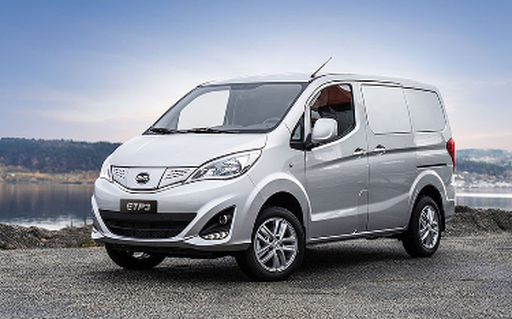BYD ETP3 vs Mercedes Sprinter Transporter – Performance, range & efficiency compared
Everyday use, family trips or long-distance drives – here’s where the differences show.
Discover whether BYD ETP3 or Mercedes Sprinter Transporter fits your lifestyle better.
Costs and Efficiency:
When it comes to price and running costs, the biggest differences usually appear. This is often where you see which car fits your budget better in the long run.
Mercedes Sprinter Transporter has a a bit advantage in terms of price – it starts at 26900 £, while the BYD ETP3 costs 31600 £. That’s a price difference of around 4672 £.
As for range, the Mercedes Sprinter Transporter performs decisively better – achieving up to 444 km, about 211 km more than the BYD ETP3.
Engine and Performance:
Power, torque and acceleration say a lot about how a car feels on the road. This is where you see which model delivers more driving dynamics.
When it comes to engine power, the Mercedes Sprinter Transporter has a clearly perceptible edge – offering 204 HP compared to 136 HP. That’s roughly 68 HP more horsepower.
In terms of top speed, the BYD ETP3 performs minimal better – reaching 100 km/h, while the Mercedes Sprinter Transporter tops out at 90 km/h. The difference is around 10 km/h.
There’s also a difference in torque: Mercedes Sprinter Transporter pulls significantly stronger with 450 Nm compared to 180 Nm. That’s about 270 Nm difference.
Space and Everyday Use:
Cabin size, boot volume and payload all play a role in everyday practicality. Here, comfort and flexibility make the difference.
Seats: Mercedes Sprinter Transporter offers clearly perceptible more seating capacity – 3 vs 2.
In curb weight, BYD ETP3 is evident lighter – 1640 kg compared to 2052 kg. The difference is around 412 kg.
In maximum load capacity, the Mercedes Sprinter Transporter performs clearly better – up to 15500 L, which is about 12000 L more than the BYD ETP3.
When it comes to payload, Mercedes Sprinter Transporter decisively takes the win – 2641 kg compared to 780 kg. That’s a difference of about 1861 kg.
Who comes out on top?
Overall, the Mercedes Sprinter Transporter shows itself to be leaves the rival little chance and secures the title of DriveDuel Champion.
It convinces with the more balanced overall package and proves to be the more versatile choice for everyday use.

Mercedes Sprinter Transporter
BYD ETP3
The BYD ETP3 is a versatile electric van that seamlessly blends functionality with environmental consciousness. Its modern design is complemented by a spacious interior, making it ideal for both urban deliveries and day-to-day personal use. Advanced technology features ensure a smooth and efficient driving experience, setting a new standard in the electric vehicle market.
details @ BYD Auto / BYD Global Media
@ BYD Auto / BYD Global Media
Mercedes Sprinter Transporter
The Mercedes-Benz Sprinter Transporter is renowned for its versatility and reliability, making it a popular choice for businesses across various industries. Featuring a spacious and intelligently designed interior, it offers ample cargo space while ensuring comfort for the driver. With a reputation for durability and advanced technology, the Sprinter continues to set standards in the commercial vehicle sector.
details
 @ BYD Auto / BYD Global Media
@ BYD Auto / BYD Global Media
|
|
|
|
|
Costs and Consumption |
|
|---|---|
|
Price
31600 £
|
Price
26900 - 72900 £
|
|
Consumption L/100km
-
|
Consumption L/100km
7.9 - 12.7 L
|
|
Consumption kWh/100km
-
|
Consumption kWh/100km
27.1 - 31.5 kWh
|
|
Electric Range
233 km
|
Electric Range
194 - 444 km
|
|
Battery Capacity
-
|
Battery Capacity
56 - 113 kWh
|
|
co2
0 g/km
|
co2
0 - 333 g/km
|
|
Fuel tank capacity
-
|
Fuel tank capacity
71 L
|
Dimensions and Body |
|
|---|---|
|
Body Type
Cargo Van
|
Body Type
Cargo Van
|
|
Seats
2
|
Seats
3
|
|
Doors
5
|
Doors
4
|
|
Curb weight
1640 kg
|
Curb weight
2052 - 3166 kg
|
|
Trunk capacity
-
|
Trunk capacity
-
|
|
Length
4460 mm
|
Length
5932 - 7367 mm
|
|
Width
1720 mm
|
Width
1993 mm
|
|
Height
1875 mm
|
Height
2331 - 2663 mm
|
|
Max trunk capacity
3500 L
|
Max trunk capacity
9000 - 15500 L
|
|
Payload
780 kg
|
Payload
577 - 2641 kg
|
Engine and Performance |
|
|---|---|
|
Engine Type
Electric
|
Engine Type
Electric, Diesel
|
|
Transmission
Automatic
|
Transmission
Automatic, Manuel
|
|
Transmission Detail
-
|
Transmission Detail
Reduction Gearbox, Manual Gearbox, Automatic Gearbox
|
|
Drive Type
Rear-Wheel Drive
|
Drive Type
Rear-Wheel Drive, All-Wheel Drive
|
|
Power HP
136 HP
|
Power HP
114 - 204 HP
|
|
Acceleration 0-100km/h
-
|
Acceleration 0-100km/h
-
|
|
Max Speed
100 km/h
|
Max Speed
90 km/h
|
|
Torque
180 Nm
|
Torque
300 - 450 Nm
|
|
Number of Cylinders
-
|
Number of Cylinders
4
|
|
Power kW
100 kW
|
Power kW
84 - 150 kW
|
|
Engine capacity
-
|
Engine capacity
1950 cm3
|
General |
|
|---|---|
|
Model Year
2023
|
Model Year
2024 - 2025
|
|
CO2 Efficiency Class
A
|
CO2 Efficiency Class
A, G
|
|
Brand
BYD
|
Brand
Mercedes-Benz
|
What drive types are available for the BYD ETP3?
The BYD ETP3 is offered with Rear-Wheel Drive.
The prices and data displayed are estimates based on German list prices and may vary by country. This information is not legally binding.
